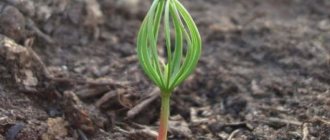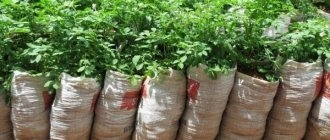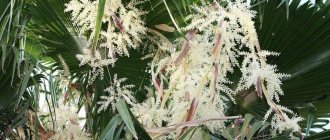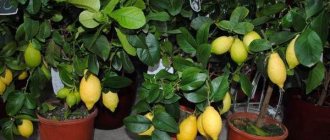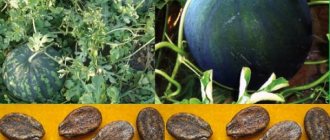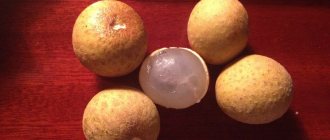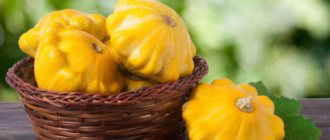Brief description of the plant
Pineapple (Ananas comosus), unlike most species from the Bromeliaceae family, does not grow on the tops of trees, but on the ground. Peduncles with fruits sometimes reach significant sizes (up to 1.5 meters in height). The plant is native to South America but is cultivated throughout the tropics.
The fruits look a little like a cone, which is reflected in the English name of the plant - pineapple. The botanical name of pineapple comes from the American word, local Indians called it “nana”.
The plant produces rosettes of numerous, long, saber-shaped, stiff leaves with pointed tips and sharp-toothed edges, arranged in a spiral around a short stem. The underside of the leaf blades is light, covered with a white coating, the upper side is shiny, entirely green, in decorative varieties it is creamy or with a pinkish border.
In nature, the plant grows to a height of 1 meter; when grown at home, it rarely reaches large sizes. The average dimensions are as follows: height – 50-60 cm, width – 50 cm.
Pineapple flowers: inconspicuous, tubular, purple, numerous, arranged tightly, in a spiral around the shoot of the inflorescence, forming an oval-shaped bulb. Usually there are more than a hundred flowers. Flowering occurs in June – July. Over time, oval, seedless fruits develop from the fused pedicels, sepals and ovaries, with a trail of leaves at the top, called the crown.
Pineapple fruits develop without flower pollination (parthenocarpic) or after pollination. In our climate they ripen in August. The ripe fruit is golden in color and weighs about 1 kilogram.
On plantations, fruits are harvested before they become completely soft, otherwise they do not tolerate transportation and storage well. Therefore, store-bought fruits are not as fragrant and sweet as those ripened on plants. But you can fully experience their taste without even going to the tropics. It is enough to plant them on the windowsill.
The pineapple fruits that we buy in stores have a crown of leaves at the top. It will take a little time and patience to transform your pineapple into a plant that bears delicious fruit. In our climate, it bears fruit in greenhouses and winter gardens. Edible pineapple can be grown in pots on apartment windowsills.
Criteria for choosing fruit to grow from the top
High quality planting material is the key to success in growing not only pineapple, but also any other crop. When choosing, focus on the following indicators:
- Appearance of the fruit - a pineapple should have an attractive appearance, a fairly elastic light brown peel without any green stuff. When pressing, depressions should not form, indicating that the fruit is overripe. The top should have a pale green tint and should never be dried out. Unripe fruit, as well as overripe fruit, cannot be used for germination.
- Appearance of leaves - leaves should be uniform in color, without inclusions or lesions. The presence of holes, black and white mold, and torn leaf edges indicates damage that will not allow the desired sprout to be obtained. If you carefully move the leaves apart, you can see the presence of emerging shoots, which is a sign of the preservation of all natural biological processes in the pineapple.
- Evaluation of smell and taste - the fruit should have a sweetish pleasant aroma and taste. The sour smell of fermentation indicates overripeness of the fruit and the development of putrefactive processes. This kind of pineapple will not be able to germinate.
Statistics show that fruits purchased in the spring and summer are more effective in germination. If you are not sure about the quality of pineapples, you can buy several samples in different stores. So the chances of getting a fruit-bearing bush will increase several times.
Which position should I choose?
Pineapple is not winter-hardy and must be grown in a pot at home. However, he can spend the warm summer months outside. The ideal position should meet the following conditions:
- well-lit place;
- warm air – temperature not less than 25 °C;
- window sill from east or west;
- covered terrace, balcony;
- in winter it is a little cooler (18-19 °C).
Lack of light causes poor pineapple growth and leaf wilting.
If the air temperature in summer is not high, it is better to leave the plant in a sunny place in the apartment, where it will find the necessary conditions. In summer, edible pineapple grows best at temperatures of 25 degrees Celsius. It grows healthier if there is warm and fresh air (greenhouses need to be ventilated regularly). Tolerates heat up to 38 degrees. At higher temperatures, the fruit may deteriorate from the inside (it looks healthy from the outside).
Attention! If the air temperature in the room where the pineapple grows decreases for a long time, the plant begins to rot.
How does pineapple grow in nature?
When you mention pineapples, many people imagine palm groves where pineapples grow like apples of paradise.
Reality is very different from fantasy: for the curious, it often becomes a real discovery that pineapple grows on the ground .
How do pineapples grow and what is a “pineapple tree” like?
Pineapple is a herbaceous plant from the genus Bromeliads, and it does not grow on trees or palms, as many people imagine. For food consumption, only varieties obtained from a single species are grown - large-tufted pineapple .
Interesting! There are quite a lot of uncultivated varieties of shrubs.
Where do pineapples grow, in which countries?
The birthplace of pineapple is considered to be Brazil, Colombia, Paraguay and Venezuela. It was from South America, along with tobacco and coffee, that it came to Europe thanks to Columbus.
The crop is grown on an industrial scale in South America, Australia, and Africa.
Bloom
Under plantation conditions, a young bush begins to bloom approximately six months after planting .
A peduncle appears in the center of a rosette of hard leaves, and small red-pink or purple inflorescences form at its top .
The set berries quickly grow together with each other and form a hard crust that hides the sweet pulp of the fruit.
Pineapple plantations
A pineapple plantation is a huge field planted with even rows of herbaceous bushes about a meter high.
When planting bushes, be sure to maintain a distance of at least 1.5–2 meters , since cultivated pineapple reproduces not by seeds, like its wild counterpart, but by lateral layering.
If all maintenance standards are observed (weeding, fertilizing and timely watering), 2-3 harvests are harvested from the plantation per year.
What soil and pot is suitable?
Pineapple in its homeland is accustomed to the sandy soil of the tropics and does not need large amounts of nutrients. Therefore, the soil is suitable for growing cacti. The soil needs to be well-drained, optimally acidic (pH 4.5-5.5) or neutral - pH no more than 7. Pineapples like watering with soft water, such as rain (it deoxidizes the soil less). They will grow well in a mixture of compost soil, acidic peat, perlite and sand.
To keep the substrate free of pests and fungi, it can be heated for 15 minutes in the oven or microwave at a temperature of 150-160 °C.
When planting a pineapple, it is important to know the following:
- pineapple does not tolerate stagnation of water;
- a drainage layer is needed in the pot - a few centimeters of coarse gravel or expanded clay, thanks to which the roots will have easy access to air;
- It is necessary to place pieces of ceramics or stone over the drain hole so that excess water flows freely.
What kind of pineapple can I plant?
For cultivation, the upper leafy part of the fruit is needed. The crown of leaves at the apex contains the growing point for new shoots. Before purchasing, you need to check the fruit for spoilage, especially in the green part. You should choose a fruit with the following characteristics:
- The top leaves should be fresh and green, not dry due to long storage.
- If the fruit has lost its leaves, choose another fruit.
- The fruit chosen is mid-ripening - with beautiful yellow, but not soft, pulp.
A crown with a cut or damaged top is not suitable for growing!
Choosing the right pineapple
Buying a Pineapple
How to Grow a Pineapple from the Top? To do this you need to choose the right fruit. To do this, use the following recommendations:
- When choosing, you should pay attention to the color of the leaves. They must be of high quality and solid. For homemade pineapple, you should not take fruit with brown and yellow leaves.
- It is very important that the peel is golden yellow.
- If the fruit is healthy, it has moderate elasticity. A fruit that is hard may be underripe, while a fruit that is too soft is of poor quality and may be overripe.
- The best time to plant pineapple is the third ten days of August or the beginning of autumn. In winter, there is a danger that the pineapple may be slightly frostbitten. This is unlikely to make a healthy plant.
- And it is also very important that the peel of the fruit does not have gray spots, they indicate rot of the fruit.
How to choose a gray pineapple
Only the right choice of fruit can give a good result.
How to prepare and root a seedling?
Preparation and rooting of the top - step by step:
- How to trim the top. The top can be cut off with a sharp knife and any remaining pulp removed. However, it is better to hold the leaves with one hand and try to unscrew them from the fruit, like a screw. Rolling is quick and more effective than top trimming, since improper trimming can lead to rot. With one hand we grab the fruit, with the other we hold a bunch of leaves at the base and try to carefully twist it out of the fruit, as if unscrewing a jar. If successful, the leaves and conical base should remain in the bunch.
- You can remove a few of the lower leaves to expose the stem.
- The prepared apical seedling should be set aside for 2 weeks to dry.
- The pineapple tail is then placed in a vessel of water or wet sand. Place it on the south window. Rooting in water is a little more difficult because the fruits don't like a lot of moisture. It is important that the water remains below the level of the leaves. Sometimes you need to change the water, check the bottom of the outlet and the roots.
- It is important to maintain a high indoor temperature. At an optimal temperature of 25-30 degrees Celsius, germination occurs within 2 weeks.
Photo. How to root the top of a pineapple - step by step
How to plant?
- You can plant when the first roots appear, this will be visible by the fact that the first young leaves begin to appear. If the pineapple is germinating in water, wait until the roots are 3-5mm long. A rooted seedling can be planted in a pot and placed on a windowsill, but not in direct sunlight.
- Before placing the rosette in the pot, remove the leaves from the bottom of the seedling to a height of about 2 cm. This way we open the shoot from which the roots will grow. Place the seedling in the pot so that the cut shoot is completely underground. The planting depth must be selected so that the lower garland of leaves protrudes above the surface of the substrate. You can support the seedling with wooden sticks.
- After planting, water the plant. In the following days, we check the soil moisture daily. Water moderately; pineapples do not tolerate excess water well.
- The seedling takes about 3 weeks to take root. Establishment is successful when new large leaves begin to grow from the rosette. The lower leaves may begin to dry out and fall off, this is normal.
Growing and care
The position for the pineapple should be bright and ventilated. But the young plant should not be exposed to direct sunlight. Only mature specimens can be moved to a very sunny place - the fruits must spend 8-10 hours in the sun every day to grow well. In summer, plants can be taken out into the garden, onto the terrace, or balcony. The exotic plant is susceptible to frost, which means it needs to be returned to the room at the end of September-October (depending on the region).
Watering
Pineapple needs more water in summer than in winter. Although the plant can go without water for a long time, in the summer heat it should be watered generously, but rarely. The next watering is carried out when the top layer of the substrate in the pot dries out a little. During the period of setting and growing fruits, the plant needs more water, but it cannot be flooded - after each watering, the water remaining in the pan must be drained.
You need to remember a few rules for watering pineapple:
- use soft water without scale;
- rainwater is ideal;
- the substrate must be constantly moist and must not dry out.
High air humidity is also needed. In winter, it is advisable to spray the apartment daily with water from a spray bottle or place the plant next to a humidifier. The plant is sprayed only in winter, during the heating season, when the air in the apartment is dry. Spraying too intensively and retaining water in the rosette can lead to rotting of the leaves.
To increase the humidity around the plant, you can place the pot on a stand filled with pebbles and water so that the drainage holes in the bottom of the pot do not touch the water.
What to fertilize with?
Pineapple needs moderate feeding. It is enough if he receives nutrients every 2 weeks in the summer and every 4 weeks in the winter. Fertilizers for bromeliads or small doses of liquid fertilizers for flowering plants added to irrigation water are suitable.
Attention! You should never apply fertilizer directly to dry substrate, as this can damage the roots and cause burns.
Care
Typically, pineapple blooms for 3-4 years. After flowering, the fruits will appear in six months. The peculiarity of the plant is that after flowering and fruiting, it usually dies. But before this, it creates growths from the underground part or young shoots in the axils of the leaves.
What to do if the pineapple does not bloom for a long time? You can cover it with colorless film for a week and put apples under it. The ethylene released by apples should initiate the formation of inflorescences.
Yellowed or wilted leaves should be removed regularly. They look unsightly and rob the plant of its ability to produce healthy leaves. The leaves of the plant cannot be polished.
Advice. Pineapple leaves have sharp edges; you should wear protective gloves when caring for them.
Pineapple can be planted immediately in a fairly large pot. No soil replacement required. When the roots completely fill the inside of the pot, the plant should be replanted (after fruiting).
Wintering
Pineapple, as a tropical plant, needs warmth all year round. In winter, the temperature should not fall below 18 °C. In the immediate vicinity of the plant, it is necessary to provide high air humidity.
Diseases and pests
Pineapples generally grow healthy. It gets sick when the soil is too wet or it is left in too humid air.
Excess moisture at low temperatures can cause the base of the pineapple to rot. This manifests itself in the falling soft leaves. It is necessary to remove dead parts of the plant, let it dry for 2-3 days, then replant it in a substrate with added sand. Water sparingly, allowing the plant to dry out between treatments.
When the plant receives little light, the pineapple leaves turn pale. The plant should be moved to a sunny place.
Reproduction
Pineapple is propagated in 3 ways:
- Rarely - by seeds.
- By shoots - if shoots grow at the base of the plant, they are left for several months at the mother plant, then separated and placed in a mixture of sand and peat for rooting. In spring, rooted seedlings can be transplanted into new pots. After planting, place the plants in the shade for a few days, then move them to a bright location. During the first 3 weeks, a temperature of 25 degrees C and high air humidity are required.
- From the top of the fruit - the technology is described above.
Knowing how to grow a pineapple at home from the top, you can enjoy the delicious fruits of your own production. It is necessary to provide the plant with suitable conditions - appropriate soil, constant warmth, high air humidity, sufficient light, moderate watering. The reward for careful care will be a small but tasty fruit.
Diseases and pests
Pineapple that grows at home is also not immune to diseases and pests. Mostly problems arise when care rules are not followed.
There may be several problems:
- The leaves began to dry. This happens when the room is too hot or the plant gets too much sunlight. To prevent the plant from drying out, it needs to be sprayed, watered if necessary and left in a cooler place.
- The leaves begin to turn pale and curl. This happens due to insufficient sunlight. You need to put the pineapple in a brighter place or add additional lighting.
- The trunk begins to rot. This occurs due to excess moisture, so you need to reduce watering until the pineapple is completely restored.
- A film appears on the leaves. This is a consequence of the life activity of the mealyworm. You need to apply a soapy solution, wash each leaf with it and treat it with Karbofos.
- Damage to the root system - a root worm has appeared. Here you need to stop watering and treat the soil with insecticides.
- A rosette in a thin web. This is the activity of a spider mite. The cobweb itself can be removed with a soap solution, and spider mites are killed by insecticides.
- The appearance of a sticky coating on the leaves. This is honey dew. To combat the disease, a soap solution is also used.
Thus, growing pineapple yourself at home is not as difficult as it might seem at first glance. This is a rather interesting process, although you will have to wait several years for the fruits to appear. How to grow pineapples at home is described in detail in this article; the main thing is to monitor watering and temperature conditions, because this is a southern plant. It is the correct care that will ensure the rapid ripening of the sweet, aromatic fruit right in the apartment.
